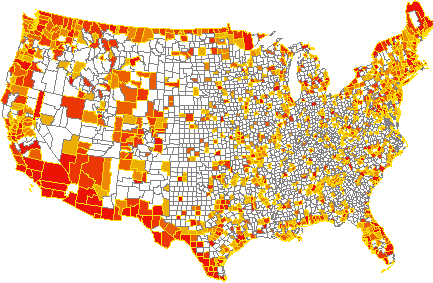|
SPECIAL NEWS ADVISORY |
|
Syracuse, N.Y.— August 25 — One out of every twelve civilian employees currently working for the federal government is on the payroll of the Department of Homeland Security (DHS), according to a special study by the Transactional Records Access Clearinghouse (TRAC).
The study also pinpointed the work stations where the 160,201 employees of this very new agency are based. About 90 percent of them are concentrated in just 166 of the nation's 3,000-plus counties. But one in five counties has a full-time DHS employee.
The DHS personnel records analyzed by TRAC list more than 300 different occupations within the department. An overwhelming majority of the employees, however, are classified within eight occupational specialties where they work as various kinds of "watchers" or investigators.
Because the DHS came to life as the third largest cabinet-level department only a few months ago, the first records about its day-to-day actions are only now beginning to come in. But extensive information is currently available about DHS employees-where they work, what they are paid, what they do and the agencies within the DHS that employ them. Also available in TRAC's report are data documenting staff changes between 9/11/01 and March 31, 2003.
In the period since 9/11, the total number of civilian employees in the federal government has increased sharply-by 4.5%. Almost all of this surge was the result of the government's response to the attacks-specifically the hiring of 69,266 employees by the Transportation Security Administration. (Not counting the TSA, federal workers would have increased by about one half of one percent since 9/11.)
The explosive growth in TSA -from zero to 69,266-was of course not matched in any of the existing government agencies placed under the DHS umbrella in the last few months. From 9/11/01 to March 2003, civilian employees in the now re-named INS increased 7.1%, Customs by 4.4 %, the Secret Service by 2.8%, in the Coast Guard by 2.2%, and the Federal Emergency Management Agency decreased by -1.1%. Recently TSA started cutting back its staff.
Not surprisingly, DHS employees are not equally distributed around the nation. A map of the United States displaying department employees by county shows a heavy ring around the borders, with just a scattering in the interior.
Department of Homeland Security
Location of Full-time Staff
March 2003
lowhigh
The map graphically portrays the judgement of the DHS that guarding the nation's major international airports and its borders are the department's top priorities. This focus may well be correct. But as the 1995 bombing of the federal building in Oklahoma City and the more recent mailing of anthrax spores have demonstrated, airports and borders are not the only place where homeland security can be challenged.
The data further indicate that not all borders are equal. For a variety of historical and political reasons, for example, US border guards have long been heavily concentrated along the border with Mexico. With 7,815 border guards along the southwest border and only 515 (6%) assigned to the much longer border with Canada, this is still true. In yet another anomaly, the March 2003 data show that not a single border patrol guard is stationed on the Alaska-Canadian border.
[To see the first of TRAC's special reports on the DHS - as well as a series of explanatory maps, graphs and tables - go to TRAC Reports.]
(TRAC, associated with Syracuse University, is a non-partisan organization established in 1989 to provide the American people with comprehensive information about the operations of the federal government. Its operations have been supported by the university and a number of philanthropic organizations including the Knight Foundation, the Rockefeller Family Fund, the Open Society Institute, the Beldon Fund, and the New York Times Company Foundation.)
WWW: http://trac.syr.edu
E-mail: trac@syr.edu
Washington, D.C.: Suite 200, 1718 Connecticut Avenue, N.W., 20009
Tel. (202) 518-9020
Syracuse: 488 Newhouse II, Syracuse, NY 13244-2100 Tel. (315) 443-3563
